Leadership and Teamwork Dynamics in Paramedic Teams: Ambulance Service
VerifiedAdded on 2020/06/06
|5
|1184
|52
Report
AI Summary
This report provides an analysis of paramedic teams within the ambulance service, focusing on the critical aspects of leadership and teamwork. It examines the different types of teams, including formal, informal, temporary project/task teams, and permanent groupings, highlighting their structures, roles, and functions in emergency situations. The report emphasizes the importance of these teams in providing rapid response and effective patient care. It discusses the size variations of teams and the specific responsibilities of each team type, such as the formal teams that provide advanced medical interventions and the informal teams that are formed during high-demand emergency scenarios. The report also explores the role of temporary project/task teams, like evaluation teams, and permanent groupings, such as the operation department, emphasizing their significance in ensuring efficient emergency services. The report is supported by references to relevant books and journals, providing a comprehensive overview of teamwork and leadership within the context of ambulance services.
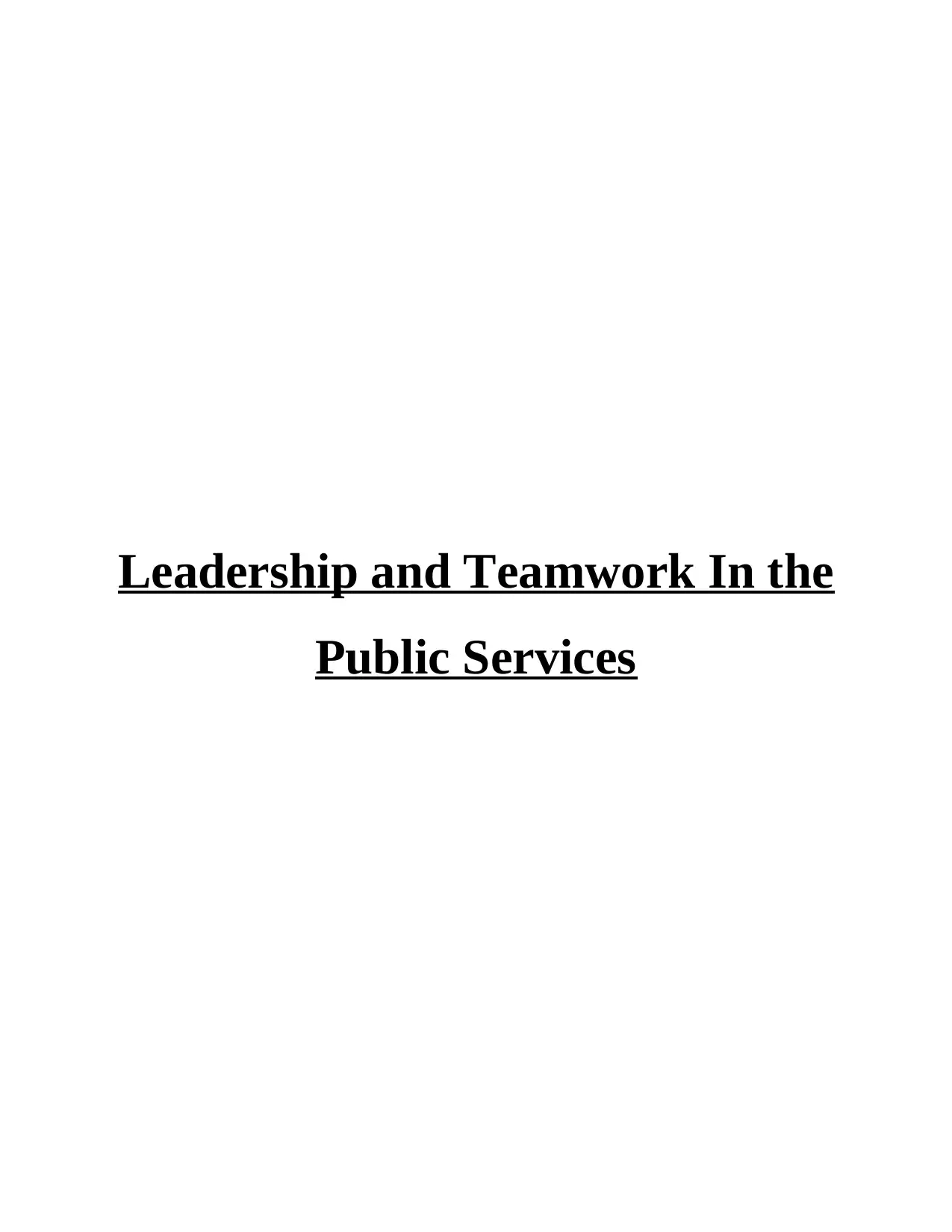
Leadership and Teamwork In the
Public Services
Public Services
Paraphrase This Document
Need a fresh take? Get an instant paraphrase of this document with our AI Paraphraser
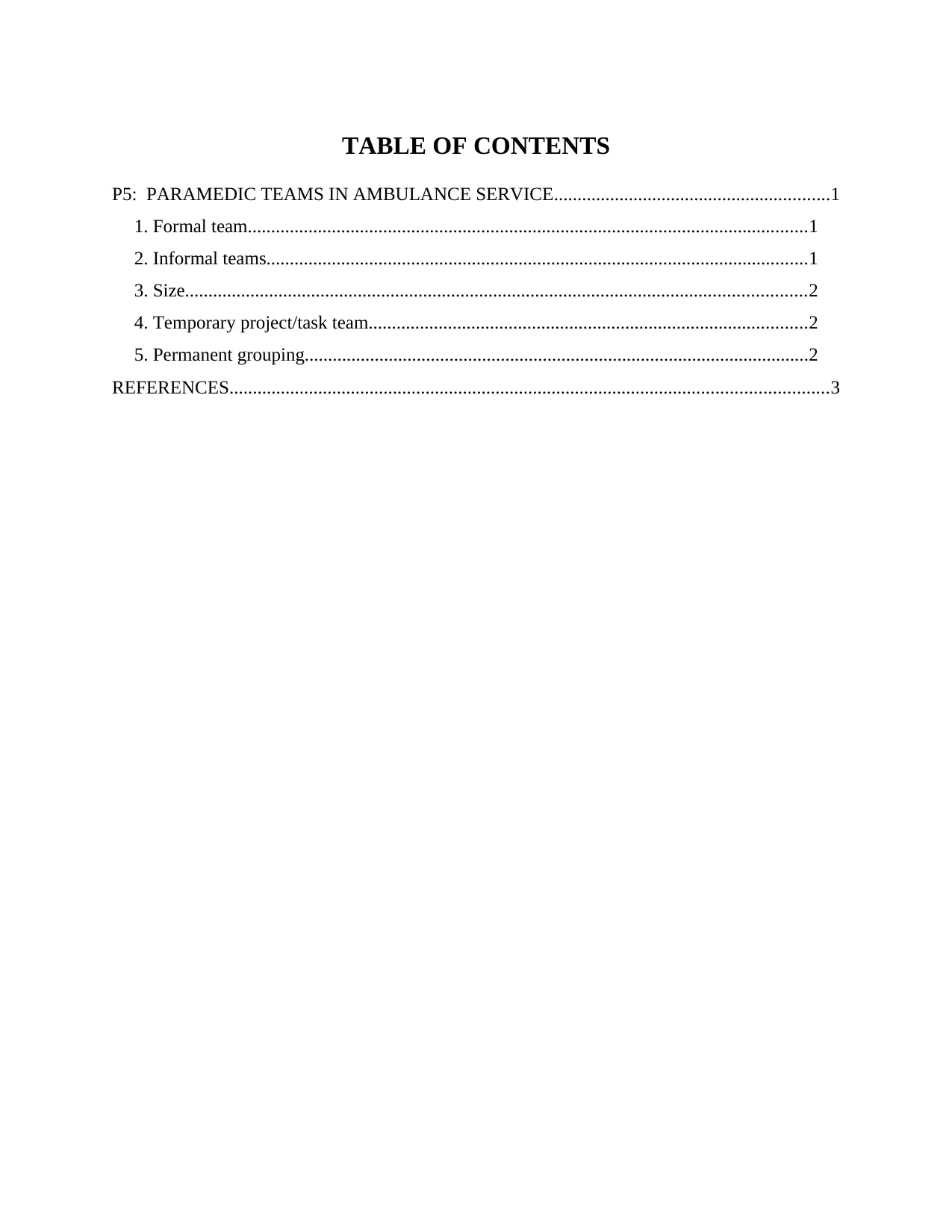
TABLE OF CONTENTS
P5: PARAMEDIC TEAMS IN AMBULANCE SERVICE...........................................................1
1. Formal team........................................................................................................................1
2. Informal teams....................................................................................................................1
3. Size.....................................................................................................................................2
4. Temporary project/task team..............................................................................................2
5. Permanent grouping............................................................................................................2
REFERENCES................................................................................................................................3
P5: PARAMEDIC TEAMS IN AMBULANCE SERVICE...........................................................1
1. Formal team........................................................................................................................1
2. Informal teams....................................................................................................................1
3. Size.....................................................................................................................................2
4. Temporary project/task team..............................................................................................2
5. Permanent grouping............................................................................................................2
REFERENCES................................................................................................................................3
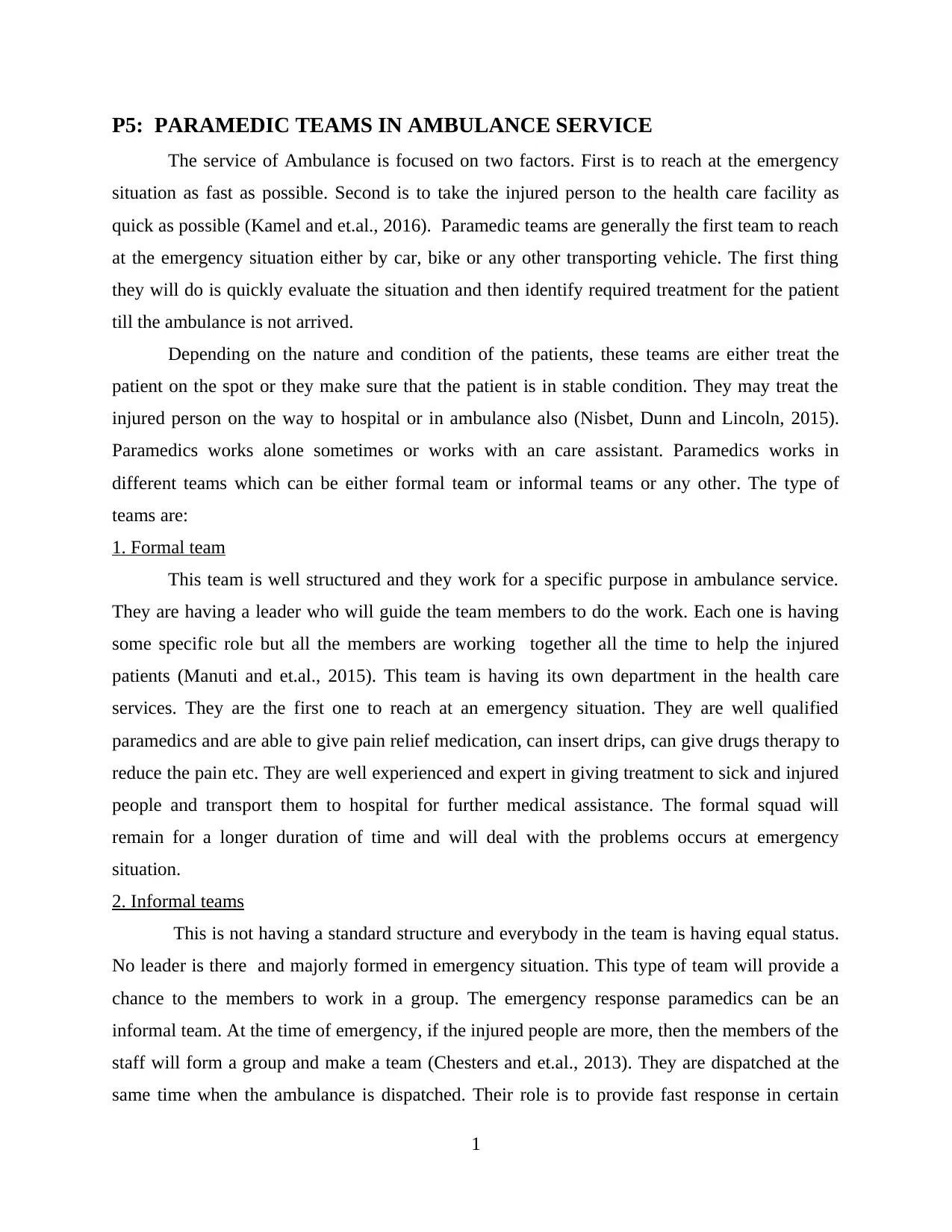
P5: PARAMEDIC TEAMS IN AMBULANCE SERVICE
The service of Ambulance is focused on two factors. First is to reach at the emergency
situation as fast as possible. Second is to take the injured person to the health care facility as
quick as possible (Kamel and et.al., 2016). Paramedic teams are generally the first team to reach
at the emergency situation either by car, bike or any other transporting vehicle. The first thing
they will do is quickly evaluate the situation and then identify required treatment for the patient
till the ambulance is not arrived.
Depending on the nature and condition of the patients, these teams are either treat the
patient on the spot or they make sure that the patient is in stable condition. They may treat the
injured person on the way to hospital or in ambulance also (Nisbet, Dunn and Lincoln, 2015).
Paramedics works alone sometimes or works with an care assistant. Paramedics works in
different teams which can be either formal team or informal teams or any other. The type of
teams are:
1. Formal team
This team is well structured and they work for a specific purpose in ambulance service.
They are having a leader who will guide the team members to do the work. Each one is having
some specific role but all the members are working together all the time to help the injured
patients (Manuti and et.al., 2015). This team is having its own department in the health care
services. They are the first one to reach at an emergency situation. They are well qualified
paramedics and are able to give pain relief medication, can insert drips, can give drugs therapy to
reduce the pain etc. They are well experienced and expert in giving treatment to sick and injured
people and transport them to hospital for further medical assistance. The formal squad will
remain for a longer duration of time and will deal with the problems occurs at emergency
situation.
2. Informal teams
This is not having a standard structure and everybody in the team is having equal status.
No leader is there and majorly formed in emergency situation. This type of team will provide a
chance to the members to work in a group. The emergency response paramedics can be an
informal team. At the time of emergency, if the injured people are more, then the members of the
staff will form a group and make a team (Chesters and et.al., 2013). They are dispatched at the
same time when the ambulance is dispatched. Their role is to provide fast response in certain
1
The service of Ambulance is focused on two factors. First is to reach at the emergency
situation as fast as possible. Second is to take the injured person to the health care facility as
quick as possible (Kamel and et.al., 2016). Paramedic teams are generally the first team to reach
at the emergency situation either by car, bike or any other transporting vehicle. The first thing
they will do is quickly evaluate the situation and then identify required treatment for the patient
till the ambulance is not arrived.
Depending on the nature and condition of the patients, these teams are either treat the
patient on the spot or they make sure that the patient is in stable condition. They may treat the
injured person on the way to hospital or in ambulance also (Nisbet, Dunn and Lincoln, 2015).
Paramedics works alone sometimes or works with an care assistant. Paramedics works in
different teams which can be either formal team or informal teams or any other. The type of
teams are:
1. Formal team
This team is well structured and they work for a specific purpose in ambulance service.
They are having a leader who will guide the team members to do the work. Each one is having
some specific role but all the members are working together all the time to help the injured
patients (Manuti and et.al., 2015). This team is having its own department in the health care
services. They are the first one to reach at an emergency situation. They are well qualified
paramedics and are able to give pain relief medication, can insert drips, can give drugs therapy to
reduce the pain etc. They are well experienced and expert in giving treatment to sick and injured
people and transport them to hospital for further medical assistance. The formal squad will
remain for a longer duration of time and will deal with the problems occurs at emergency
situation.
2. Informal teams
This is not having a standard structure and everybody in the team is having equal status.
No leader is there and majorly formed in emergency situation. This type of team will provide a
chance to the members to work in a group. The emergency response paramedics can be an
informal team. At the time of emergency, if the injured people are more, then the members of the
staff will form a group and make a team (Chesters and et.al., 2013). They are dispatched at the
same time when the ambulance is dispatched. Their role is to provide fast response in certain
1
⊘ This is a preview!⊘
Do you want full access?
Subscribe today to unlock all pages.

Trusted by 1+ million students worldwide
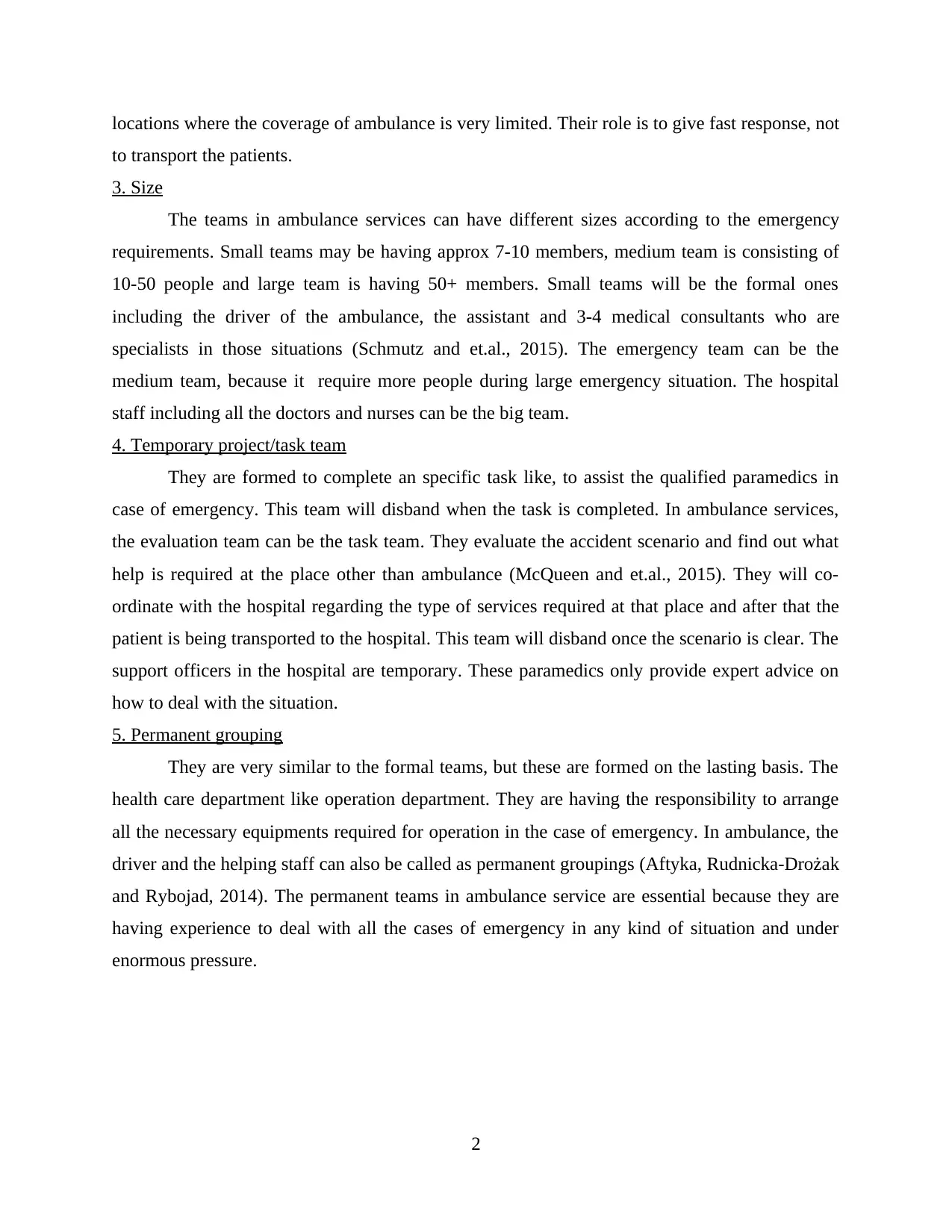
locations where the coverage of ambulance is very limited. Their role is to give fast response, not
to transport the patients.
3. Size
The teams in ambulance services can have different sizes according to the emergency
requirements. Small teams may be having approx 7-10 members, medium team is consisting of
10-50 people and large team is having 50+ members. Small teams will be the formal ones
including the driver of the ambulance, the assistant and 3-4 medical consultants who are
specialists in those situations (Schmutz and et.al., 2015). The emergency team can be the
medium team, because it require more people during large emergency situation. The hospital
staff including all the doctors and nurses can be the big team.
4. Temporary project/task team
They are formed to complete an specific task like, to assist the qualified paramedics in
case of emergency. This team will disband when the task is completed. In ambulance services,
the evaluation team can be the task team. They evaluate the accident scenario and find out what
help is required at the place other than ambulance (McQueen and et.al., 2015). They will co-
ordinate with the hospital regarding the type of services required at that place and after that the
patient is being transported to the hospital. This team will disband once the scenario is clear. The
support officers in the hospital are temporary. These paramedics only provide expert advice on
how to deal with the situation.
5. Permanent grouping
They are very similar to the formal teams, but these are formed on the lasting basis. The
health care department like operation department. They are having the responsibility to arrange
all the necessary equipments required for operation in the case of emergency. In ambulance, the
driver and the helping staff can also be called as permanent groupings (Aftyka, Rudnicka-Drożak
and Rybojad, 2014). The permanent teams in ambulance service are essential because they are
having experience to deal with all the cases of emergency in any kind of situation and under
enormous pressure.
2
to transport the patients.
3. Size
The teams in ambulance services can have different sizes according to the emergency
requirements. Small teams may be having approx 7-10 members, medium team is consisting of
10-50 people and large team is having 50+ members. Small teams will be the formal ones
including the driver of the ambulance, the assistant and 3-4 medical consultants who are
specialists in those situations (Schmutz and et.al., 2015). The emergency team can be the
medium team, because it require more people during large emergency situation. The hospital
staff including all the doctors and nurses can be the big team.
4. Temporary project/task team
They are formed to complete an specific task like, to assist the qualified paramedics in
case of emergency. This team will disband when the task is completed. In ambulance services,
the evaluation team can be the task team. They evaluate the accident scenario and find out what
help is required at the place other than ambulance (McQueen and et.al., 2015). They will co-
ordinate with the hospital regarding the type of services required at that place and after that the
patient is being transported to the hospital. This team will disband once the scenario is clear. The
support officers in the hospital are temporary. These paramedics only provide expert advice on
how to deal with the situation.
5. Permanent grouping
They are very similar to the formal teams, but these are formed on the lasting basis. The
health care department like operation department. They are having the responsibility to arrange
all the necessary equipments required for operation in the case of emergency. In ambulance, the
driver and the helping staff can also be called as permanent groupings (Aftyka, Rudnicka-Drożak
and Rybojad, 2014). The permanent teams in ambulance service are essential because they are
having experience to deal with all the cases of emergency in any kind of situation and under
enormous pressure.
2
Paraphrase This Document
Need a fresh take? Get an instant paraphrase of this document with our AI Paraphraser
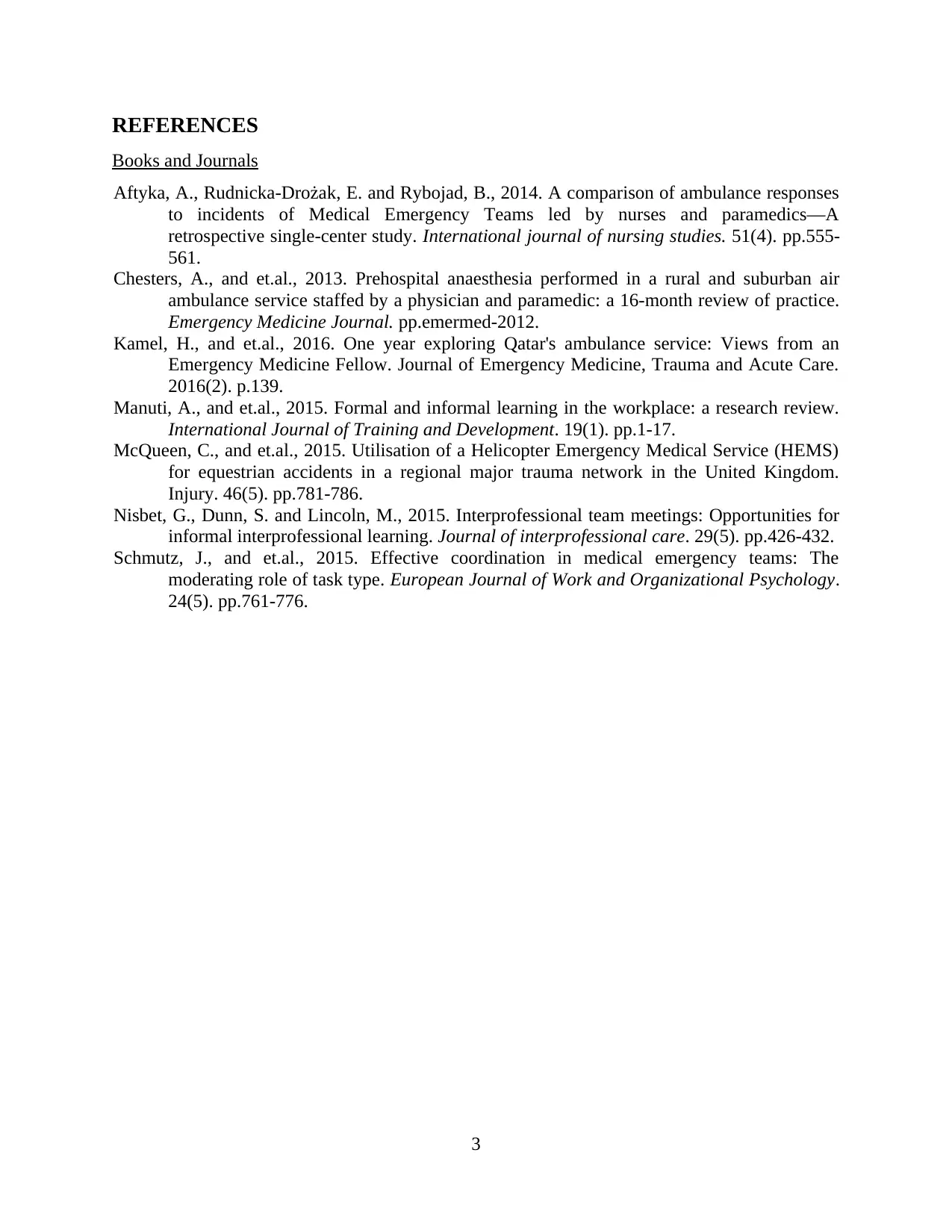
REFERENCES
Books and Journals
Aftyka, A., Rudnicka-Drożak, E. and Rybojad, B., 2014. A comparison of ambulance responses
to incidents of Medical Emergency Teams led by nurses and paramedics––A
retrospective single-center study. International journal of nursing studies. 51(4). pp.555-
561.
Chesters, A., and et.al., 2013. Prehospital anaesthesia performed in a rural and suburban air
ambulance service staffed by a physician and paramedic: a 16-month review of practice.
Emergency Medicine Journal. pp.emermed-2012.
Kamel, H., and et.al., 2016. One year exploring Qatar's ambulance service: Views from an
Emergency Medicine Fellow. Journal of Emergency Medicine, Trauma and Acute Care.
2016(2). p.139.
Manuti, A., and et.al., 2015. Formal and informal learning in the workplace: a research review.
International Journal of Training and Development. 19(1). pp.1-17.
McQueen, C., and et.al., 2015. Utilisation of a Helicopter Emergency Medical Service (HEMS)
for equestrian accidents in a regional major trauma network in the United Kingdom.
Injury. 46(5). pp.781-786.
Nisbet, G., Dunn, S. and Lincoln, M., 2015. Interprofessional team meetings: Opportunities for
informal interprofessional learning. Journal of interprofessional care. 29(5). pp.426-432.
Schmutz, J., and et.al., 2015. Effective coordination in medical emergency teams: The
moderating role of task type. European Journal of Work and Organizational Psychology.
24(5). pp.761-776.
3
Books and Journals
Aftyka, A., Rudnicka-Drożak, E. and Rybojad, B., 2014. A comparison of ambulance responses
to incidents of Medical Emergency Teams led by nurses and paramedics––A
retrospective single-center study. International journal of nursing studies. 51(4). pp.555-
561.
Chesters, A., and et.al., 2013. Prehospital anaesthesia performed in a rural and suburban air
ambulance service staffed by a physician and paramedic: a 16-month review of practice.
Emergency Medicine Journal. pp.emermed-2012.
Kamel, H., and et.al., 2016. One year exploring Qatar's ambulance service: Views from an
Emergency Medicine Fellow. Journal of Emergency Medicine, Trauma and Acute Care.
2016(2). p.139.
Manuti, A., and et.al., 2015. Formal and informal learning in the workplace: a research review.
International Journal of Training and Development. 19(1). pp.1-17.
McQueen, C., and et.al., 2015. Utilisation of a Helicopter Emergency Medical Service (HEMS)
for equestrian accidents in a regional major trauma network in the United Kingdom.
Injury. 46(5). pp.781-786.
Nisbet, G., Dunn, S. and Lincoln, M., 2015. Interprofessional team meetings: Opportunities for
informal interprofessional learning. Journal of interprofessional care. 29(5). pp.426-432.
Schmutz, J., and et.al., 2015. Effective coordination in medical emergency teams: The
moderating role of task type. European Journal of Work and Organizational Psychology.
24(5). pp.761-776.
3
1 out of 5
Related Documents
Your All-in-One AI-Powered Toolkit for Academic Success.
+13062052269
info@desklib.com
Available 24*7 on WhatsApp / Email
![[object Object]](/_next/static/media/star-bottom.7253800d.svg)
Unlock your academic potential
Copyright © 2020–2025 A2Z Services. All Rights Reserved. Developed and managed by ZUCOL.





